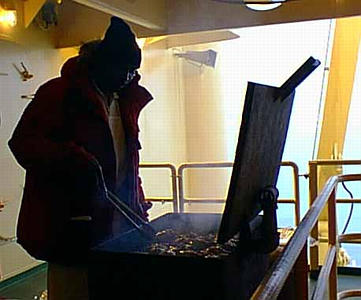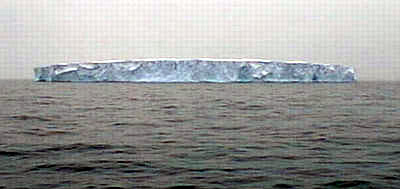
|
|
23 February, 1999
February 23, 1999
Hi from Antarctica! When I woke up this morning, we were already on our
way to Sulzberger Bay. It was decided sometime during the night that we
would collect seismic data during most of the transit. Although this makes
our journey a little slower, it provides good data that we can use to help
determine the glacial history of the area. We continued the seismic line
throughout our entire shift, and the night shift will be towing seismic
gear for their entire shift, too. Sometime tomorrow, we will be completing
a few multibeam surveys in the area and choosing some locations in which to
core.
One noticeable difference today was in the amount of ice that we saw.
Until now, we saw an occasional iceberg (but it was usually off in the
distance). Today, we saw lots of icebergs! In addition, we went through
some patches of ice that were really neat. I tried to take pictures, but
it was really gray and foggy out today, so most of them didn't turn out
like I had hoped. I'm sure that this is the beginning of things to come.
I'll be sure and send some nice iceberg and sea ice pictures to the web
site as soon as I can. By the way, what's the difference between icebergs
and sea ice? That will be the topic of tomorrow's journal.
For today, our question was "Who was Richard Evelyn Byrd?" He is best
known for being the first man to successfully fly over the South Pole in
1929. He had also claimed to be the first man to fly over the North Pole
in 1926, but many people believe that he missed his mark and didn't really
fly over the North Pole itself. In order to raise the money for his trip
to Antarctica, Richard Byrd had sponsors such as Charles Lindbergh, the
National Geographic Society, and the New York Times (which gained exclusive
rights to the story and had the privilege of sending its own reporter along
on the expedition).
At this time in history, only two other expeditions had ever reached the
South Pole, and neither one of them had used airplanes. Remember,
airplanes were not as common in 1929 as they are today. Before setting off
on this journey, Byrd had to have a depot of fuel set up so that the plane
could make it to the South Pole and back. Byrd had taken three planes to
Antarctica with him, but one plane was blown about 800 meters by high winds
and crashed in a blizzard (even though it was tied down). The plane that
he ended up flying to the South Pole was named "Floyd Bennett," after his
North Pole pilot who had died of pneumonia earlier that year.
Byrd was the navigator of the flight. There were three other men that
accompanied him aboard the Floyd Bennett -- a chief pilot, a second
pilot/radio operator, and a photo surveyor. They took off on November 28,
1929, for the South Pole. They had some trouble with the plane not being
able to gain enough altitude due to the cold temperatures. They ended up
throwing some food overboard to lighten their load, and the pilot caught a
tiny updraft near a glacier to finally give them enough lift. They found
the exact location of the South Pole by using a sextant. After they
arrived, they stood at the South Pole for a few seconds and then flew back
to their base on the Ross Ice Shelf (after stopping to refuel at their
depot). The entire trip took about 16 hours. When Byrd returned to the
United States, he was a national hero. There were parades in his honor, he
was promoted to Rear Admiral, and he was given a special gold medal made in
his honor. Although he returned to Antarctica for four other expeditions
(and some of them were much more scientific), this was Byrd's most notable
achievement.
During Byrd's second expedition (1933-1935), a lot of scientific knowledge
about Antarctica was learned. Byrd and his party determined that there was
no strait of water connecting the Ross and Weddell Seas, which proved that
Antarctica was a single continent. They also measured the depth of the ice
sheet, they identified many new species of animals, and they collected a
lot of data about Antarctic weather. It was while studying the weather
that Byrd nearly asphyxiated himself with carbon monoxide. For this
project, he was living alone in a small hut that was buried in the ice of
the Ross Ice Shelf. Only the roof was above the ground. He began his
research on March 28, 1934, and he maintained a tiny weather station
throughout the Antarctic winter. A malfunction in his stove caused carbon
monoxide fumes to build up in his hut. He was very close to death when he
was rescued on August 10, 1935. In fact, it took nearly 2 months before he
was strong enough to leave his hut and be flown back to the expedition's
main base, named Little America, which was located about 123 miles to the
north.
Well, it's really late and I need to be heading to bed. The seas are
totally calm now, so everyone should sleep really well tonight. It's nice
that the seas were so calm for Ernest to BBQ our dinner. We had awesome
chicken, hamburgers, hot dogs, eggplant, and crab cakes. It was great!
Well, If you think of any questions, don't hesitate to send them to me. I
wonder what fun things I'll be seeing tomorrow . . .
Kim Giesting
Latitude: 76 degrees 29 minutes South
Longitude: 154 degrees 37 minutes West
Temperature: -6 degrees C
Barometer: 996.9 mb
Wind Speed: 2.4 knots
Wind Direction: 054 degrees (from the northeast)
Sunrise today: 02:07
Sunset today: 20:42

Ernest is on the deck grilling our dinner!

This is one of the many icebergs that we have seen today.
Contact the TEA in the field at
.
If you cannot connect through your browser, copy the
TEA's e-mail address in the "To:" line of
your favorite e-mail package.
|
